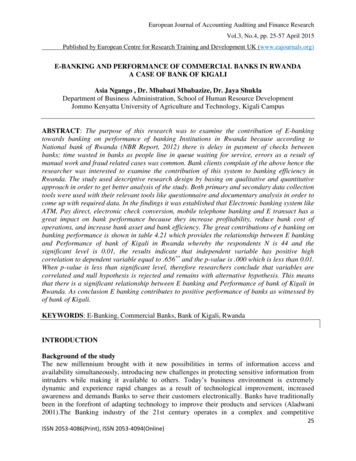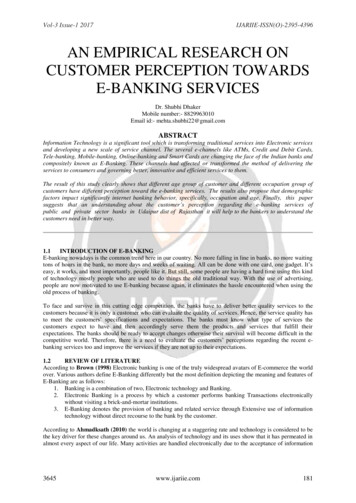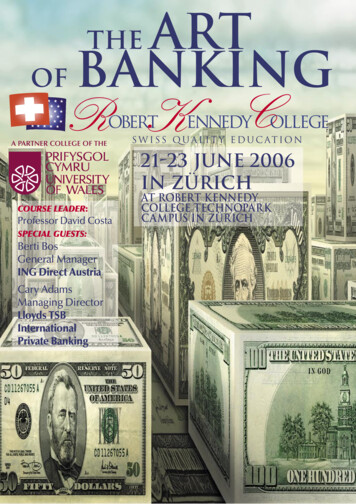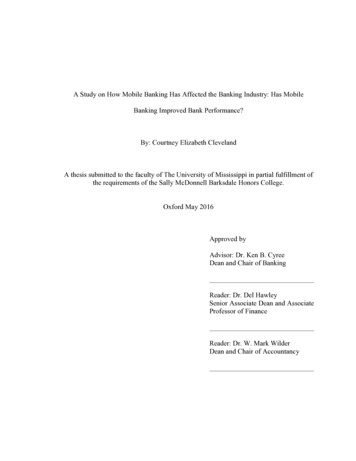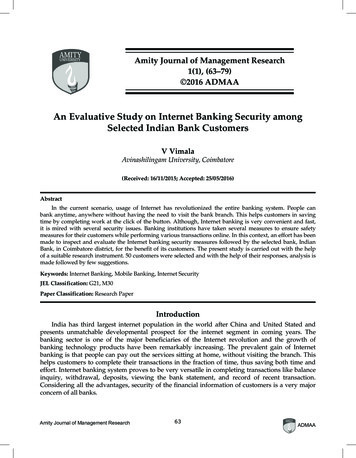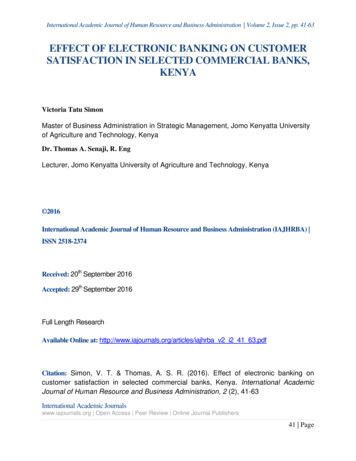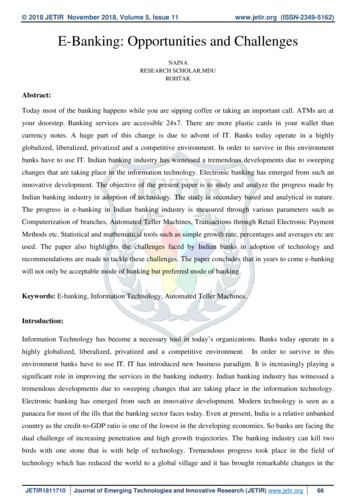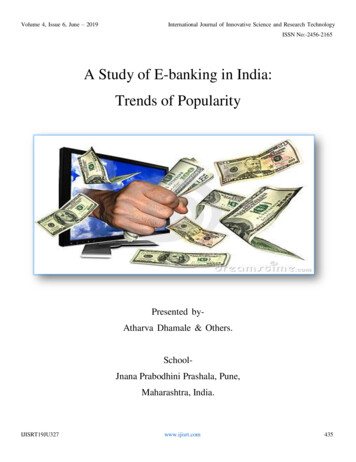
Transcription
Volume 4, Issue 6, June – 2019International Journal of Innovative Science and Research TechnologyISSN No:-2456-2165A Study of E-banking in India:Trends of PopularityPresented byAtharva Dhamale & Others.SchoolJnana Prabodhini Prashala, Pune,Maharashtra, India.IJISRT19JU327www.ijisrt.com435
Volume 4, Issue 6, June – 2019International Journal of Innovative Science and Research TechnologyISSN No:-2456-2165ACKNOWLEDGEMENTWhile doing this research, many People gave us various suggestions and opinions while conducting theproject. We have tried to incorporate all those suggestions which are really relevant in preparing our final report.We think it is essential to thank all those who have contributed and helped us throughout the project.We pay our immense gratitude to Rajatjoshi and Mrs. Mukulikathatte for their continuous and deliberatediscussion on the topic and indeterminable burden taken by them in helping us throughout conducting the project.We would also like to thank our friends who rendered their wholehearted co-operation in the successfulcompletion of the project work.Finally, we are thankful to all the people who willingly responded to the questionnaire and their contributionhas been valuable. This project would not have been completed without their participation.IJISRT19JU327www.ijisrt.com436
Volume 4, Issue 6, June – 2019International Journal of Innovative Science and Research TechnologyISSN No:-2456-2165ABSTRACTToday, India is fastest developing country in the world and after demonitisation in 2016, there issurge in E-banking sector of India. E-banking is now a key component of today’s digitalised world. In thisstudy, we collected data about past of E-banking in India, analysed present situation of E-banking in Indiaby taking surveys and tried to predict the future of E-banking sector in India.In this study, we studied 7 different factors related to E-banking in India, which are as follows1.Different modes of transaction2.No. Of users3.Technological advancements in E, banking4.Net amount of transactions in E. banking5.Government policies6.Awareness in public7.Use of different services offered by E-bankingWe then conducted a survey in Pune city and outskirts to get the required data after which weanalyzed it and tried to determine the possible future. In the survey we had asked various questions liketheir preferred mode of banking, No of transactions per week done by them.Then we analyzed the data collected from survey and RBI, and find out some conclusions using theanalysis we tried to predict the future in two phases.IJISRT19JU327www.ijisrt.com437
Volume 4, Issue 6, June – 2019International Journal of Innovative Science and Research TechnologyISSN No:-2456-2165INDEX1.Introduction2.System web3.Survey introduction4.Survey data analysis5.SWOT analysis6.Predicted future-introduction7.Data analysis and future predictions8.Predicted future-phase I&II9.Desirable future-phase I&II10. Action plans11. Conclusion12. ReferencesIJISRT19JU327www.ijisrt.com438
Volume 4, Issue 6, June – 2019International Journal of Innovative Science and Research TechnologyISSN No:-2456-2165CHAPTER-1INTRODUCTION Why We Chose this Topic?We all were interested in studying the economy of India and other countries. We discussed various topicssuch as demonetization, G6etc., but then understanding the importance of banks in the lifeline of Indian economywe chose E-banking as our topic for futurology project. When we came across various factors affecting physicalas well as E-banking, we decided to finalize our topic. First we listed various factors related to our topic andsegregated them based on various categories such as Age, Educational qualification etc. After studying about it,we understood various factors affecting the E-banking in India and we chose the topics we would like to workon. Overall Structure of the ProjectAs mentioned earlier we choose 7 main categories to segregate our data. Those factors were,1) Mode of transactions for e.g.Cash, Cards, Internet banking etc.In our subject mode of transactions plays a vital role and for the same reason we have considered this factor.We have mainly bifurcated this factor into 4 parts Cash transactions Transactions by Cheque Transactions with the use of Plastic Money (i.e. Credit cards, Debit cards, Smart card) Online transactions2) Services offered in E-bankingThis factor is mainly divided into 2 parts1}Services offered by government like Jan Dhan Yojana2}Services offered by private companies like PAYTM,Paypal etc.This factor highly affects the number of E-banking users and for the same reason we have considered this factorIJISRT19JU327www.ijisrt.com439
Volume 4, Issue 6, June – 2019International Journal of Innovative Science and Research TechnologyISSN No:-2456-21653) Awareness about E-bankingMany people are not well aware about E-banking and do not know much about it.Due to ineffectiveimplementation of Govt.policies and some other reasons E-banking has not reached all the places and hencepeople are not using it on greater extent4) Government policiesAs mentioned earlier Gov. Is trying to initiate various schemes like Jan DhanYojana which is going tomake E-banking sector even to the poorest sections of the society and for the same reason we have chosen thisfactor.5) TechnologyToday the Modi government is trying to implement more and more schemes as well as policies which willhelp in making Indian economy the Cashless economy. For these new technological advancements such asBiometric system, eye scanner etc. This is going to affect the development of E-banking sector on a greaterextent. Therefore we have chosen this as an important factor6) Volume of transactionsFor studying this topic one of the most important factor to be taken in the consideration is volume oftransactions. Under this factor we have studied number of transactions as well as amount of transactions (inmillions).We wanted to know how the people are transacting throughout the India and how the number oftransactions will be affected by the wild card decision of Demonetization and for the same reason we havetaken this factor into consideration.7) Number of usersAs mentioned before the number and amount of transactions is ultimately dependent upon the number ofusers. If there are no users of a particular system that system will not able to sustain for a long time. Thinkingsimilarly about E-banking sector we have chosen this as an important factorIJISRT19JU327www.ijisrt.com440
Volume 4, Issue 6, June – 2019International Journal of Innovative Science and Research TechnologyISSN No:-2456-2165CHAPTER-2SYSTEM WEBFig 1IJISRT19JU327www.ijisrt.com441
Volume 4, Issue 6, June – 2019International Journal of Innovative Science and Research TechnologyISSN No:-2456-2165CHAPTER-3SURVEY INTRODUCTION For case study a survey was conducted from November2016 to December2016 for the project .This surveywas done on the basis of 500 respondents from various sectors. Mainly the objective of the research is to understand online banking user’s behaviors, opinions, preferencesand expectations Duration of survey- 1-11-16 to 15-12-16 Target population- Local people of Pune city and surroundings Survey method- Direct interview and form filling Total no. of respondents- 500Survey QuestionnaireE-Banking survey*name not required*{E-banking includes ATM, debit or credit cards, online payments, online transactions, online shopping,paytm and other digital wallets also }*Please tick on appropriate answer*1) Do you use e-banking?-Yes /No(If you are not using e-banking then answer only question no.1, 2, 3, 6, 7 &8)Reason of using ebanking instead of normal banking is (1 or 2 lines)IJISRT19JU327www.ijisrt.com442
Volume 4, Issue 6, June – 2019International Journal of Innovative Science and Research TechnologyISSN No:-2456-21652) Age-AGE20-3030-4040-5050-6060-7070 3) Qualification or education-Qualification graduateGraduatePost graduate post graduate4) If you want to do transaction of RS5000 or more then which mode will you prefer?(please give sequencefrom first preference to last preference by giving rank 1 to 6 in descending order.)Mode of transactionsCashChequeDebitcardCredit cardonlinePaytm or bit coins(give preference from1 to 6)Why you gave first preference to this mode? (Mode which you gave 1 st preference above)6) How many times you do online transactions per week?No. of transactions0-33-66-99 or 9 IJISRT19JU327www.ijisrt.com443
Volume 4, Issue 6, June – 2019International Journal of Innovative Science and Research TechnologyISSN No:-2456-21656) Are you well informed about e banking-Yes/No7) Living areaUrbanSub urbanRural8) If you are not using e-banking, then reason behind it is-ReasonI)less information about e-bankingII)online bank account is not activatedIII)misconceptions or security reasonsIV)other9) Kindly give preference of the followings of your online banking services:(Give preference in descending order from 1 to 9)servicespreferencefund transferATM bankingBALANCE ENQUIRYONLINE FIXED DEPOSITREQUEST A DEMAND DRAFTPAY BILLONLINE SHOPPINGONLINE RECHARGEOTHERIJISRT19JU327www.ijisrt.com444
Volume 4, Issue 6, June – 2019International Journal of Innovative Science and Research TechnologyISSN No:-2456-216510] In your opinion which online operations should be modified promptly for better services in future? (Pleasetick on only 1 or 2 services)servicesATM servicesAccount servicesFund transferBill paymente-tax paymente-depositInvestments and servicesLoans and credit servicesInternet security services11] Give your overall rating in online banking services.EXCELLENTIJISRT19JU327VERY GOODGOODAVERAGEwww.ijisrt.comPOORHARD TO SAY.445
Volume 4, Issue 6, June – 2019International Journal of Innovative Science and Research TechnologyISSN No:-2456-2165CHAPTER-4SURVEY- DATA ANALYSIS1) NUMBER OF PEOPLE USING E-BANKINGNo of E-Bank UsersNo of People Not using E-Banking68%32%PREFFERENCE FOR THE USE OF E BANKING% people using E Banking% people not using E BankingFig 2Here we can observe that according to survey around 68% of the total people who answered the survey areusing e-banking. Today in India (according to RBI statistics) around 35 % of the population is using E-Bankingfor daily transactions. In the near future this number will increase by 50-60%.IJISRT19JU327www.ijisrt.com446
Volume 4, Issue 6, June – 2019International Journal of Innovative Science and Research TechnologyISSN No:-2456-21652) FREQUENCY OF TRANSACTIONS PER WEEK0-351%3-622%6-915%9 12%FREQUENCY OF TRANSACTIONS PER WEEK60no. of people5040Series130201000 to 33 to 66 to 99 frequency of transactions per weekFig 3According to the data the frequency is for 0-3 transactions per week. Out of every 100 persons nearly 50%do less than 3 online transactions per week. As we all know DEMONITIZATION is going to change thissituation completely. Here we can see that nearly 12% people are doing on an average 9 and more transactionsper week. According to our prediction in the near future this percentage will increase by two- foldsIJISRT19JU327www.ijisrt.com447
Volume 4, Issue 6, June – 2019International Journal of Innovative Science and Research TechnologyISSN No:-2456-21653) PREFERENCE FOR USE OF VARIOUS SERVICESOnline payment32%Balance enquiry14%ATM banking22%Fund transfer26%Other services6%PREFERENCE FOR THE USE OF VARIOUS SERVICES35No of people302520151050Online paymentBalance enquiryATM bankingFund transferOther servicesOnline banking servicesFig 4The graph clearly tells us that the service used mostly by the people is Online Payment. People prefer topay online rather than visiting the place physically to pay. Nearly 32% people use the service of online paymentmostly. The second most used service is Fund Transfer accounting to about 26%. The third most used service isATM Banking accounting to about 22%. There are various modes by which the funds can be transferredbetween two accounts, but if we look at the % of people doing fund transfer by various means like cash ,,Cheque ,Online etc. we can see that from these 22% around 21% do transactions by cash, 38%transact byCheque and 41% do transactions online.IJISRT19JU327www.ijisrt.com448
Volume 4, Issue 6, June – 2019International Journal of Innovative Science and Research TechnologyISSN No:-2456-21654) SERVICES TO BE IMPROVEDATM Services18%Account services8%Fund transfer5%Bill payment8%E-Tax payment9%E Deposits6%Investment and Services7%Loans and Credit services6%Internet security services33%No of peoplePREFFERENCE FOR VARIOUS SERVICES TO BE IMPROVED35302520151050Online banking servicesFig 5Here we can clearly observe that the highest percentage of people , that is 33% people want Internetsecurity services to be improved.This clearly indicates the fact that Official Govt. sites are highly insecure andthere is risk of Hacking and Misuse of confidential data. Today it is surprising to see that our online bankaccount, credit card number etc. can be hacked only in 6 seconds. There is an urgent need to improve theseservices.IJISRT19JU327www.ijisrt.com449
Volume 4, Issue 6, June – 2019International Journal of Innovative Science and Research TechnologyISSN No:-2456-2165Further 18% people want ATM services to be improved. Today more than 30% financial frauds are doneby using ATM cards. The ATM card pin can take few seconds to be hacked. On the other hand only 5% peoplewant Fund transfer service to be improved. Based on this we can conclude that , according to the survey , todaythe most secure service offered in E-banking sector is Fund transfer.5) REASONS FOR NOT USING E-BANKINGNot well informed30%Inactivated online bank account27%Misconceptions/Security reasons26%Others27%VARIOUS REASONS FOR NOT USING E BANKING31No of people30292827262524Reasons for not using E BankingFig 6Here are some of the important reasons for which the people are not using E-banking. We can observe thatmost percentage of the people are not using E-banking because they are Not Well Informed about E-banking.Around 30% people are not aware about, some very basic questions like how to do banking transactionsonline? What things we need to do online transactions and many more basic questions about E-bankingThis clearly indicates that there is an urgent need to organize awareness and information campaigns onE-banking. Secondly around 27% of the people are not using E-banking because of the inactivated onlineIJISRT19JU327www.ijisrt.com450
Volume 4, Issue 6, June – 2019International Journal of Innovative Science and Research TechnologyISSN No:-2456-2165account. At last we can observe that around 26% of the people are not using E-banking because ofmisconceptions and security reasons. This clearly indicates that there is a need for organizing information andawareness campaigns on E-banking.6) PREFERENCE TO MODES OF h11%PREFFERENCE FOR THE USE OF VARIOUS MODES OFTRANSACTIONScreditonlinechequedebitcashFig 7This graph shows the modes of transactions preferred by people. 27% people have given the firstpreference to the Online mode of transaction. This is the highest percentage among other modes but still we canobserve that it is very less. There can be variety of reasons for such a small percentage of people using Onlinemode of transaction. Some of these reasons we can see in graph no.5.Further 25% of people prefer Cheque as a mode of transactions. This is also a secure mode of transaction.Compared to other modes of transactions online modes provides us with variety of services.IJISRT19JU327www.ijisrt.com451
Volume 4, Issue 6, June – 2019International Journal of Innovative Science and Research TechnologyISSN No:-2456-2165CHAPTER-5SWOT ANALYSISSTRENGTHS Transparency and Disclosure practices are available almost everywhere E-banking is Facilitating the offering of more services Online services and E-banking are Increasing customer satisfaction and loyalty Competitive advantage for banks As the competition will increase banks will try launching more and more schemes reaching to the widerpublic section. Reduces the time, cost and effort in the interaction We will be able to do transactions by sitting at home within a few seconds which will reduce the timeconsumed. Infrastructure required for the setup of online services will be less leading to the effectivereduction in cost and efforts E-banking provides Permanent access to the bank It is a Safe and secure method regarding security issues Discounts and offers on Online services are attracting more customersWEAKNESSES Delayed statements of transactions are consuming a little bit of more time and thus people are thinking it tobe more time consuming Less awareness about e-banking Misconceptions about Low Internet connectivity in rural and some urban areas is preventing people from accessing online banksecurity reasons are making people use E-banking on a very small scalewebsites Lack of trust in people. People are not well aware about E-banking and think of it as a risky method. Insufficient penetration of Mobile banking in rural areas Infrastructural issues such as building banks and ATM machines in rural areas. E-banking services are costly .so, it is not affordable for poor peopleIJISRT19JU327www.ijisrt.com452
Volume 4, Issue 6, June – 2019International Journal of Innovative Science and Research TechnologyISSN No:-2456-2165 Online payments are not accepted everywhereOPPORTUNITIES Demonetization-Promoting CASHLESS transactions-demonetization is positive booster for e-banking.People don’t have any money in hand so; people have no other option other than online banking. So, peoplewill move towards E-banking Promotion of inter-connectivity between banks and customers-Today, BJP government is promotinge-banking .so, people are getting more information about E-banking and as a result e-literacy is increasing. Increased quality of online services Supporting Government policies Increasing investment in E-banking sector Increased competition among companies in E-banking sector-This may led to increase in qualities and decreased cost of services provided in E-bankingTHREATS Security problems-today ,there are many security threats in online transactions like- Card trapping Fake websites Keystroke logging Use of malware programsBecause of above threats people are not using E-banking because there is fear in minds of people aboutonline transactions Misuse of lost cards-if people don’t deactivate their cards after getting lost, then other people may misuse it. Misuse of confidential data –many times confidential data like phone no. ,password of email address andmany other things may leak while performing online transactions Development in E-banking will led to decrease in employment of people in banking sector .so, it maycreate a big problem of unemployed peopleIJISRT19JU327www.ijisrt.com453
Volume 4, Issue 6, June – 2019International Journal of Innovative Science and Research TechnologyISSN No:-2456-2165CHAPTER-6PREDICTED FUTUREDEMONITIZATION a wild card decision taken by the Modi Government proved to an important decisionfor E-banking sector in India. This introduced us to the concept of ‘CASHLESS Society', which is mostlybased on the concept of E-Banking and cashless transactions. In this section we have mainly focused onpredicted future for Credit and Debit cards, Mobile transactions, and NEFT transactions. We got our requireddata from official RBI site and tried to predict its future by figuring out the possible rates at which the usage ofthis technology will increase.Note 1]All data till January 2016 is collected from official website of Reserve Bank of India www.rbi.in2] The future is predicted by analyzing the graph and rate of change in slope and also from results of thesurvey.3] the term POS means ‘point of sale purchase.’IJISRT19JU327www.ijisrt.com454
Volume 4, Issue 6, June – 2019International Journal of Innovative Science and Research TechnologyISSN No:-2456-2165CHAPTER-7DATA ANALYSIS AND FUTURE PREDICTIONNumber of transactions1) MOBILE 000000001000000000NUMBER OF MOBILE TRANSACTIONSYearFig 8This graph shows the number of mobile transactions from Dec.11 to Jan.16. Here during jan.15 to dec.15we can observe the drastic increase in number of transactions mainly due to the government change. Modi govt.initiated various policies and schemes which are helping to boost the number of online transactions. That is themain reason, according to our predictions this will keep increasing at the steady rate over next 5 years.IJISRT19JU327www.ijisrt.com455
Volume 4, Issue 6, June – 2019International Journal of Innovative Science and Research TechnologyISSN No:-2456-21652)CREDIT CARDS-NO. OF EXISTING CARDS - CREDITNo of existing Credit 0000011- 12- 12- 13- 13- 14- 14- 15- 15- 16- 16- 17- 17- 18- 18- 19- 19- 20- 20- 21Dec Jan Dec Jan Dec Jan Dec Jan Dec Jan Dec Jan dec Jan Dec Jan Dec Jan Dec JantotalYearFig 9In this graph we can observe 3 lines,1) The curve line represents how the total number of existing credit cards will increase exponentially in thenear future that is in the next 5 years till January 20212) Black dotted line represents the linear growth of the total number of existing credit cards in the near futurethat is in the next 5 years till January 20213) Similarly red dotted line represents the linear growth that is going to take place in the number of existingcredit cards as a result of ‘demonetization’ in the near future that is in the next 5 years till January 2021IJISRT19JU327www.ijisrt.com456
Volume 4, Issue 6, June – 2019International Journal of Innovative Science and Research TechnologyISSN No:-2456-2165Here as represented if we observe the graph carefully, we can observe that the black line is clearlyindicating the lineargrowth in the total number of existing credit cards in the upcoming 5 years, with respectto the data from December 2011 to January 2016, but in reality this is not going to happen due to the wild carddecision of DEMONITIZATION. Demonetization is promoting the idea of cashless society, which is going toaffect this trend of E-banking on a greater extent. According to black dotted line the total number of existingcredit cards is going to increase 4% per annum but because of demonetization this can become two fold andaccording to our predicted future this will increase by average 6% to 8% per annum.NO. OF TRANSACTIONS OF CREDIT CARDS - ATM250000000No of DecYear17Jan17- 18dec Jantotal18Dec19Jan19Dec20Jan20Dec21JanFig 10IJISRT19JU327www.ijisrt.com457
Volume 4, Issue 6, June – 2019International Journal of Innovative Science and Research TechnologyISSN No:-2456-2165In this graph also we can observe 3 lines,1) The curve line represents how the total number of transactions done by credit cards at ATM will increaseexponentially in the near future that is in the next 5 years till January 20212) Black dotted line represents the linear growth of the total number of transactions done by credit cards atATM in the near future that is in the next 5 years till January 20213) Similarly red dotted line represents the linear growth that is going to take place in the total number oftransactions done by credit cards at ATM as a result of DEMONITIZATIONin the near future that is inthe next 5 years till January 2021As mentioned above total number of existing credit cards is going to increase by 6% to 8% per annum, aspredicted,from the graph above we can conclude that according to the black dotted line average annual growthin no of transactions done by credit cards at ATM is increasing at an average rate of 3.5% per annum, similar tothe situation above due to the wild card decision of DEMONITIZATION, this increase will be 6% to 7% perannum according to our prediction. Such a large % increase in total number of credit card transactions is seenbecause, according to the RBI data and our survey data, more than 50% population per 100 persons transact onan average 0 to 3 times per week , but in the upcoming 2 to 3 years number of these transactions will be morethan 9 transactions per week according to our predictions. This is the main reason for why we are going towitness such a large increase in number of transactions by credit cards in the near futureNO OF TRANSACTIONS OF CREDIT CARDS - POSNo of transactions2500000200000015000001000000500000011- 12- 12- 13- 13- 14- 14- 15- 15- 16- 16- 17- 17- 18- 18- 19- 19- 20- 20- 21Dec Jan Dec Jan Dec Jan Dec Jan Dec Jan Dec Jan dec Jan Dec Jan Dec Jan Dec JantotalYearFig 11IJISRT19JU327www.ijisrt.com458
Volume 4, Issue 6, June – 2019International Journal of Innovative Science and Research TechnologyISSN No:-2456-2165In this graph also we can observe 3 lines,1) The curve line represents how the total number of transactions done by credit cards at POSwill increaseexponentially in the near future that is in the next 5 years till January 20212) Black dotted line represents the linear growth of the total number of transactions done by credit cards atPOSin the near future that is in the next 5 years till January 20213) Similarly red dotted line represents the linear growth that is going to take place in the total number oftransactions done by credit cards at POSas a result of DEMONITIZATIONin the near future that isin the next 5 years till January 20214) As mentioned above total number of existing credit cards is going to increase by 6% to 8% per annum, aspredicted,from the graph above we can conclude that according to the black dotted line average annualgrowth in no of transactions done by credit cards is increasing at an average rate of 10% per annum, similarto the situation above due to the wild card decision of DEMONITIZATION, this increase will be 16% to17% per annum according to our prediction. Such a large % increase in total number of credit cardtransactions is seen because, according to the RBI data and our survey data, more than 50% population per100 persons transact on an average 0 to 3 times per week , but in the upcoming 2 to 3 years number of thesetransactions will be more than 9 transactions per week according to our predictions. This is the main reasonfor why we are going to witness such a large increase in number of transactions by credit cards at POS inthe near futureIJISRT19JU327www.ijisrt.com459
Volume 4, Issue 6, June – 2019International Journal of Innovative Science and Research TechnologyISSN No:-2456-2165AMOUNT OF TRANSACTIONS BY CREDIT CARDS ATM1400000000Amount of 400000000200000000011- 12- 12- 13- 13- 14- 14- 15- 15- 16- 16- 17- 17- 18- 18- 19- 19- 20- 20- 21Dec Jan Dec Jan Dec Jan Dec Jan Dec Jan Dec Jan dec Jan Dec Jan Dec Jan Dec JantotalYearFig 12IJISRT19JU327www.ijisrt.com460
Volume 4, Issue 6, June – 2019International Journal of Innovative Science and Research TechnologyISSN No:-2456-2165In this graph also we can observe 3 lines,1) The curve line represents how the total amount of transactions done by credit cards at ATM will increaseexponentially in the near future that is in the next 5 years till January 20212) Black dotted line represents the linear growth of the total amount of transactions done by credit cards atATMin the near future that is in the next 5 years till January 20213) Similarly red dotted line represents the linear growth that is going to take place in the total amounttransactions done by credit cards at ATMas a result of DEMONITIZATIONofin the near future that isin the next 5 years till January 2021Comparing among the credit and debit cards it is clear that amount of transactions using Debit card [ATM]is going to be clearly higher than that of the Credit cards .In this graph at present i.e. January 2016 we canobserve that total amount of transactions is around 800 crores which is going to reach around 1300 crores byDecember 2021. This is the drastic increase in amount of transactions by credit cards is mainly due to the wildcard decision of Demonetization. As said earlier the increase in amount of transactions is going to increase ateven higher rates, the main reason being the less charges applied on debit cards than the credit card.600000000AMOUNT OF TRANSACTIONS BY CREDIT CARDS -POSAmount of Dec16Jan16DecYear17Jan17- 18dec Jantotal18Dec19Jan19Dec20Jan20Dec21JanFig 13IJISRT19JU327www.ijisrt.com461
Volume 4, Issue 6, June – 2019International Journal of Innovative Science and Research TechnologyISSN No:-2456-2165In this graph also we can observe 3 lines,T1) The curve line represents how the total amount of transactions done byy credit cards at POSpexponentially in the near future that is in the next 5 years till January 2021ewill increase2) Black dotted line represents the linear growth of the total amount of transactions done by credit cards atPOSin the near future that is in the next 5 years till January 2021a3) Similarly red dotted line represents the linear growth that is going to take place in the total amounttransactions done by credit cards at POSin the next 5 years till January 2021qas a result of DEMONITIZATIONuoteofin the near future that isComparing among the credit and debit cards it is clear that amount of transactions using Debit card [ATM]is going to be clearly higher than that of the Credit cards .In this graphf at present i.e. January 2016 we canroDecember 2021.This is the drastic increase in amount of transactions by mcredit cards is mainly due to the wildobserve that total amount of transactions is around 100 crores which is going to reach around 500 crores bycard decision of Demonetization. As said earlier the increase in amount of transactions is going to increase at
study, we collected data about past of E-banking in India, analysed present situation of E-banking in India by taking surveys and tried to predict the future of E-banking sector in India. In this study, we studied 7 different factors related to E-banking in India, which are as follows 1. Different modes of transaction 2. No. Of users 3.
